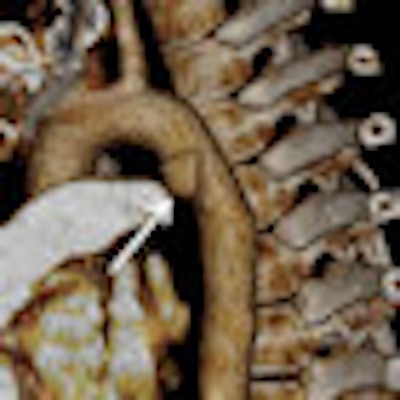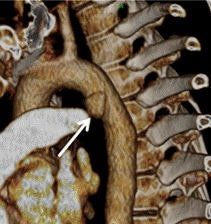
Building a successful 3D laboratory requires proper handling of challenging issues such as 3D technologist training, 3D study protocols, and capturing sufficient revenue to cover the costs of the service. But the results are worth the effort, according to Dr. Eliot Siegel of the University of Maryland School of Medicine in Baltimore.
"Advanced visualization can provide a major service to patients and referring clinicians, make your practice more efficient, and represent a major new source of revenue," Siegel said. "Strongly consider doing this if you haven't already done so."
With the ever-increasing role of 3D in today's radiology practice, institutions may be considering shifting to a dedicated 3D lab approach. In this model, specialized 3D technologists perform much of the advanced image postprocessing previously performed by traditional radiologic technologists or radiologists. Many feel that these labs allow for greater efficiency, deployment of specialized expertise, and standardization of 3D processing tasks.
In evaluating the cost-effectiveness of a potential 3D lab, institutions need to consider the cost of not having a dedicated 3D service, taking into account the potential to make radiologists more efficient, Siegel said. For example, having radiologists spend a few hours each day performing 3D processing would divert them from reading more cases and generating additional revenue. Another radiologist may even need to be hired.
Not having a 3D lab can also hamper technologist productivity. If technologists are performing advanced visualization processing in between scans, this can slow down scanner throughput and decrease revenue, Siegel said. He spoke during a refresher course cosponsored by the Society for Imaging Informatics in Medicine (SIIM) at the 2009 RSNA meeting in Chicago.
Shaving processing time
Many complex 3D exams such as CT angiography (CTA) require at least 45 to 60 minutes to process all of the associated views, while less complicated 3D studies may take only 15 to 30 minutes to process, Siegel said.
"Advanced visualization can provide a major service to patients and referring clinicians, make your practice more efficient, and represent a major new source of revenue."
— Dr. Eliot Siegel, University of Maryland School of Medicine
In a positive trend, advanced visualization vendors are increasingly using "intelligent" 3D software templates and 3D hanging protocols. Many types of processing that previously had to be handled by a 3D lab technologist can now be performed in an automated fashion, allowing the 3D technologist to tackle complex tasks that may involve some level of clinical acumen and require more training, he said.
"These tools will [also] allow the techs to be significantly faster," he said. "Rather than taking 30 minutes, it might take as little as five to 10 minutes or so to do the processing."
In looking to hire dedicated advanced visualization technologists for your lab, solid candidates would be experienced, trained, and -- ideally -- certified CT or MR technologists who can work closely with radiologists and referring physicians, Siegel said.
"The dedicated 3D technologist is akin to a computer graphics medical artist, who can create a set of concise, anatomically detailed 3D views," he said.
To reach this goal, 3D technologists must possess an in-depth understanding of cross-sectional anatomy and pathology, scan artifacts, and the operation of complex computer software, according to Siegel. Training time typically ranges from three to six months, working closely with other radiologists and 3D technologists.
At this time, there is no specific certification credential for 3D technologists, and only one or two programs in the U.S. even include 3D imaging in their radiologic technologist training, Siegel said. In general, 3D technologists are not paid significantly more than a senior MRI or CT technologist, so the recognition and associated financial reward for these 3D imaging skills is not yet at the level to drive demand for 3D training programs.
As a result, prospective 3D technologists typically must learn their craft on-the-job. At Stanford University in Stanford, CA, new hires for the 3D lab are trained from scratch in a process that can take six to eight months, Siegel said.
Technologists work with trained staff members and read educational documents. They also take skill assessment exams on different procedures, Siegel said. New hires learn not just from other technologists, but also from radiologists.
Nuts and bolts
Advanced visualization workflow is complex. As an example, at Massachusetts General Hospital (MGH) in Boston, 3D views are saved as a new series of the study on the PACS for review and also on a Web server for review by referring physicians on their PCs, according to Siegel.
After the radiologist interprets the 3D reconstruction procedures, they are finalized in the clinical information system and associated with the primary examination. If appropriate, a bill is then generated.
When outfitting their 3D lab, institutions would be wise not to forego service agreements and software updates, Siegel said. It's also possible that several different systems might be needed to be able to process any type of clinical exam; some are better at certain exams than others, he said.
"You shouldn't be constrained with any one particular vendor," he said.
 |
| Volume-rendered reconstruction of a post-traumatic aortic pseudoaneurysm. Image courtesy of Dr. Tara Morgan from the University of Maryland. |
As for turnaround time, the Stanford 3D lab aims for two to three hours, which is a reasonable goal, Siegel said.
"There's a tremendous temptation with advanced visualization for your technologist to create a really beautiful, just gorgeous artistic image," he said. "And one thing that requires some additional work is to make sure that the idea is to answer the clinical question, rather than necessarily achieve perfection."
Getting paid
One of the biggest challenges in setting up a 3D imaging service is determining how to capture revenue and demonstrate cost-effectiveness. While carrier reimbursement from Medicare and other health insurers represents the main sources of 3D imaging revenue, it's critical that services be billed only when appropriate, Siegel said.
For billing Medicare, 3D reconstructions can only be performed on software that has the required U.S. Food and Drug Administration (FDA) clearances, he said.
Advanced visualization procedure manuals can be useful for adhering to appropriate guidelines. At Stanford, for example, the advanced visualization procedure manual includes protocols and quantitative data instructions, Siegel said. And referring clinicians can provide input to radiologists for additional protocols.
At MGH, 3D studies can be initiated in a number of ways:
- A direct order from a referring physician (supported by radiologist documentation of medical necessity)
- By the radiologist (if additional views are deemed necessary; both positive findings and the reason for the additional views must appear in the report)
- By protocol if the department and/or referring physicians determine that 3D reconstructions should be performed as part of the standard of care for a particular type of examination
Coding must be performed appropriately. For many procedures, review of images in alternative display formats is built into the procedure code. However, the current procedural terminology (CPT) coding system provides for separate coding for image reformatting when such reformatting "entails complex rendering of the original image," Siegel said.
3D-related CPT codes to be reported in conjunction with the base imaging procedures include:
- CPT 76376 -- 3D rendering with interpretation and reporting of CT, MRI, ultrasound, or other tomographic modality; not requiring image postprocessing on an independent workstation
- CPT 76377 -- 3D rendering with interpretation and reporting of CT, MRI, ultrasound, or other tomographic modality; requiring image postprocessing on an independent workstation
According to the American Medical Association (AMA) and the American College of Radiology (ACR), both 3D codes require concurrent physician supervision of image postprocessing, 3D manipulation of the volumetric dataset, and image rendering, Siegel said. In cases where 3D reconstructions do not require image postprocessing on an independent workstation, the physician must discuss with the technologist the need for 3D imaging and supervise the technologist in creating the 3D images.
"This can also be part of a previously described protocol," he said.
For studies performed on an independent workstation, the physician must supervise and/or create the 3D reconstructions and adjust the projection to optimize visualization of anatomy and pathology, Siegel said.
Siegel noted that the 3D rendering codes are intended to address complex renderings such as shaded surface rendering, volumetric rendering, maximum intensity projections (MIPs), fusion with other imaging modalities, and detailed quantitative analysis such as segmental volumes and surgical planning.
The ACR emphasizes that 3D codes should only be used when medically necessary.
"When providing 3D rendering services, particularly in the outpatient setting, a specific order is helpful to justify medical necessity," he said. "The ACR states the reformatting study should be documented in a separate report or you should create a separate section of the report."
In Medicare claims, procedural CPT codes are reported with diagnosis codes describing the patient's documented medical condition.
Reimbursement for advanced visualization can be highly variable in the U.S. Medicare does not currently have a national policy addressing the application of image reformatting procedures in general, leaving coverage at the discretion of local Medicare contractors, Siegel said.
In addition, some private payors may rely on Medicare reimbursement policies while others consider alternative information, Siegel said. As a result, institutions need to consult with individual private payors regarding coverage policies.
For hospital-based radiologists, both the AMA and the ACR strongly recommend a separate report on 3D findings and that radiologists clearly state the medical necessity for the 3D rendering, Siegel said. Nonhospital-based imaging centers must have a separate order from the referring physician.
In addition, 3D codes can't be used with studies in which advanced visualization is already implied, including any CTA, MR angiography (MRA), nuclear medicine procedures (including PET), CT colonography, and cardiac CT.
Other pitfalls
With the significant variability in quantitative analysis tools among different software and a lack of understanding of the limitations of technology, quality control is mandatory for 3D labs, Siegel said.
"We have documented wide variability in measurements of tumor size, carotid stenosis, etc.," he said.
Results should be reported with a range rather than a specific number, he said.
Regarding other potential 3D lab pitfalls, radiologists and clinicians could lose their skills in interacting with the datasets if the 3D work is outsourced to a lab staffed by technologists, Siegel said. Also, image quality is very dependent on the level of technologist skill, particularly if quantitative analysis is being performed.
Also, if local expertise or volume does not warrant onsite 3D billing, consider outsourcing it to another 3D lab or service, Siegel said.
By Erik L. Ridley
AuntMinnie.com staff writer
January 14, 2010
Related Reading
3D software boosts diagnostic accuracy for Alzheimer's, December 1, 2009
3D labs require careful planning for success, July 10, 2009
Dedicated 3D server speeds up CT data processing, June 6, 2009
Enterprise-wide 3D extends radiology's boundaries, June 2, 2009
Turning your 3D lab into a profit center, May 21, 2009
Copyright © 2010 AuntMinnie.com



















